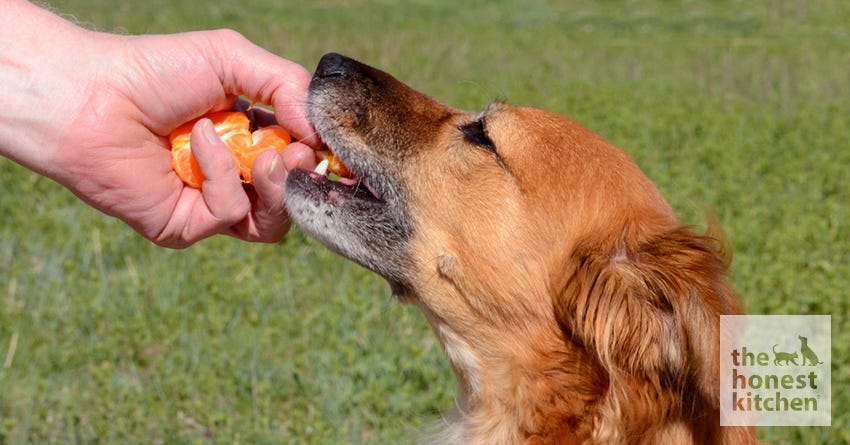Can Dogs Eat Oranges? Yes, But In Moderation

The short answer: Yes, dogs can eat oranges. This citrus fruit isn’t toxic to dogs, and most dogs can eat a slice or two without experiencing issues. Like any human food, the key is how much orange you serve your dog, as overdoing it can lead to digestive problems and other health issues.
Let’s talk about the benefits and risks of feeding your dog oranges and related citrus fruits like clementines, tangerines, and mandarins. We’ll also go over some safe ways to prepare and serve oranges to your dog.
Why Are Oranges Good for Dogs? 3 Big Benefits
Not only are oranges safe to feed to your dog, but they have a few health benefits to boot! We’ve rounded them up below.
1. Great Source of Dietary Fiber
Oranges are an excellent source of dietary fiber, which keeps your pup’s stomach feeling full and also improves their digestive health. The fiber also keeps them from absorbing the natural sugars too quickly.
2. Full of Vitamin C
Although dogs naturally produce vitamin C on their own and don’t need it in their food, adding an additional source of it doesn’t hurt. Dogs with liver disease or different metabolic requirements who can’t create enough vitamin C could get a boost from adding orange to their diet.
3. Healthy Treat Alternative for Overweight Dogs
If your dog is overweight, an orange slice is a wonderful alternative to fattening doggie treats. A small portion of this fruit provides a sweet snack that won’t add as much sugar to their diet.
When Can Oranges Be Bad For Dogs?
While it’s generally safe to feed your dog oranges, you need to be sure not to overdo it or there could be some unpleasant side effects.
First, oranges are a fiber-rich food, and giving a dog too much fiber can lead to digestion issues. If your dog has a sensitive stomach, or has had digestive problems in the past, start with a small bite of orange and keep a close eye on how much you’re feeding them.
Second, oranges contain natural sugars. For healthy dogs, this usually isn’t a problem. But if your dog has diabetes, even a small amount of sugar could cause an adverse reaction, so oranges may not be a good treat for them.
In general, it’s important not to give your dog too much of any type of fruit. Portion size and moderation is key. When it comes to oranges, you should only give your dog a wedge or two in a single sitting and watch for any side effects. Small dogs shouldn’t eat more than one-third of an orange, while large breed dogs might be able to eat a whole orange, as long as you dole it out in smaller servings.
Keep in mind that these are general guidelines — ask your veterinarian how much orange you can feed your individual dog to be absolutely sure.
Other Orange and Citrus Fruit FAQs
To recap, oranges could be your dog’s new favorite treat, but you should start slowly and keep this citrusy snack to a minimum. Here are some other frequently asked questions about dogs, oranges, and orange-like citrus fruits.
Can Dogs Eat Orange Peels?
No, your dog shouldn’t eat orange peels. Although orange peels aren’t toxic to dogs, they can be hard to digest and upset your pet’s stomach. You should also remove the orange pith, the white stringy layer between the fruit’s flesh and rind, as an extra precaution.
Is It Safe for Dogs To Drink Orange Juice?
Stay away from orange juice — even when freshly squeezed. It’s too concentrated to be a healthy choice for dogs, and it doesn’t boast the dietary fibers that make the natural sugars safe for canine consumption. Water is always the best choice to keep your dog hydrated and happy.
What About Similar Citrus Fruits, Like Mandarins, Clementines, and Tangerines?
A mandarin is a citrus fruit that’s flat on both ends and has a sweeter flavor than a typical navel orange. Clementines and tangerines are both hybrids of mandarins. The rules and guidelines about oranges also apply to mandarins, clementines, and tangerines. Your dog can eat all three, as long as you peel them, remove the seeds, and limit the amount you give them.
Clementines and tangerines tend to be sweeter than oranges, so you should be careful with dogs who shouldn’t have foods that cause blood sugar to spike. Never feed more than a half of these fruits to a smaller dog, or a whole fruit for bigger canines.
What Are the Safest Ways To Give Your Dog Oranges?
If your pup is begging for an orange slice, or you simply want to give them a sweet, healthy treat, make sure to fully peel the orange. Remove any seeds so they aren’t a choking hazard. Give them a small piece, especially if it’s their first time trying it.
You can serve your dog a raw orange wedge, freeze slices for a refreshing snack, or mix it up with other safe fruits for dogs, like apples and blueberries. Or, check out these dog treat recipes packed with fresh, zesty orange:
Health Disclaimer: This post is educational in nature and doesn’t constitute health advice. Please consult your pet's veterinarian or other healthcare professional for specific guidance on this topic.


